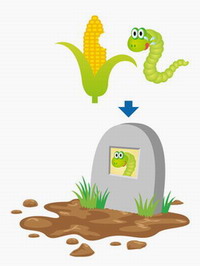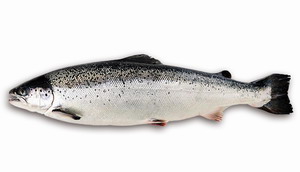Pop Out of New Genetically Modified Food ?
Previously, media reported that a giant chicken "Jetcarrier Chicken" was developed by genetic modification and it would be large enough for ploughing fields and may even be used for production of medicine. However, the story was finally confirmed to be fake. People often consider genetically modified (GM) animals are mystic, where GM animals have been portrayed for years in TV and films as biohazard organisms. It is also common that crops with unusual or special appearance are wrongly regarded as GM plants. In fact, GM food developers introduce desirable characteristics by alteration of specific existing genes or insertion of new genes, but the external appearances of these GM crops can be no different from their non-GM counterparts.
Characteristics of Genetically Modified Crops
To enhance the yield, GM food developers introduce beneficial characteristics, such as herbicide tolerance and insect resistance to various GM crops. GM crops introduced with genes conferring tolerance to specific herbicides are tolerant to those herbicides while weeds grown around them are easily killed. On the other hand, some insect-resistant crops were developed by incorporating into crops genes encoding insecticidal proteins such as Bt protein (Box 1). The specificity of the herbicides and the incorporation of insecticides in the crops lead to more effective use of these pesticides which in turn will reduce the quantity used.
Bt protein Bt protein refers to the endotoxins produced by the bacterium Bacillus thuringiensis. Actually, various subspecies of the bacterium are registered as pesticides and the bacterial preparation can be sprayed on crops. Instead of using the bacterial preparation, the genes encoding endotoxins are engineered into GM crops so that the endotoxins can be produced in the crops continuously. The expression of Bt protein in crops instead of spraying the bacterial preparation has additional advantages such as the continuous protection for crops and the avoidance of the insects remain inside the plant stem or tissue as the endotoxins generally appear in the tissues of the whole plant. As different endotoxins can protect crops from different types of insects, GM crops may be inserted with different genes encoding different endotoxins. You may be curious why these GM crops are not toxic to humans but are harmful to insects. In general, the toxins will be converted by enzymes in the guts of insects and formed the active form of the toxins. The active form of the toxins need to bind to specific receptor sites in the insect gut to produce pores and cause the death of insects. Since there are no known equivalent receptor sites in the gut of mammalian species, such toxin will not affect the mammalian species including human. In addition, the more acidic environment of the mammalian gut will also lead to degradation of Bt proteins. Bt proteins incorporated in GM foods are generally considered to be safe for human consumption. Few years ago, a GM corn, namely Starlink corn, that was restricted for feed and industrial uses because of suspected allergenicity of the incorporated Bt protein (Cry9C protein), was found in corn chips intended for human consumption . Although s ubsequent studies conducted by the U.S. Food and Drug Administration (FDA) and the Centers for Disease Control and Prevention did not reveal any cases of human allergenicity attributable to exposure to the Bt protein, such incident re-affirmed the importance of proper safety assessment on the newly developed GM crops for the protection of public. |
Genetically Modified Animals in the Pipeline
Up till now, no GM animal has been approved for food use. Having said that, some are in the pipeline as they are either seeking approval or under research and development. These GM animals are modified to enhance the overall performance, which in turn may produce agronomic and/or economic benefits.
Similar to GM plants, increase in productivity is one of the main targets of GM animal production. The most well-known example is GM salmon, featuring Atlantic salmon engineered to contain the growth hormone gene from the Chinook salmon and the on-switch genetic element allowing growth hormones to be produced continuously. Due to the effect of growth hormones, the GM salmon can grow faster than conventionally farmed Atlantic salmon and save the production cost.
Apart from introducing growth hormone, antimicrobial proteins or enzymes can be incorporated in a modified animal to decrease its susceptibility to infections. Genetic modification can also help improve animal nutrition. Gene encoding enzyme for the digestion of phosphorus compound has been introduced into pigs to make better use of phosphorus in pigs' feed. This can reduce the use of phosphate supplements and also the amount of phosphorus in pig manure. Phosphorous leaching will cause an upsurge of nutrient content in the water environments and may even lead to algal blooms. Hence, the reduction of phosphorus in pig manure can potentially benefit the environment. That's why this type of GM pig is regarded as environmental friendly.
Through biotechnology, the content of the food deriving from animals can be modified to meet consumers' needs. For example, some researchers are trying to modify the gene in cows so that they can produce milk with lowered lactose content and suitable for individuals with lactose intolerance.
Approval of Genetically Modified Salmon for Food Use
GM Pending Approval

GM salmon could be the first GM animal approved for food use but it is uncertain whether this would pave the path for other GM animals in the pipeline. The U.S. FDA concluded that food derived from the GM salmon has been assessed as safe as food from conventional Atlantic salmon. Yet, there is currently no information when the GM salmon will be approved for marketing. Some environmentalists or consumers oppose the marketing of GM salmon partly due to the concerns regarding the potential environmental impact. They have concern that the GM salmon may be accidentally released from the culture facilities and confinement measures are not sufficient to prevent the survival of the fish in the environment. The growth advantage of the GM salmon may endanger the survival of wild salmon and the modified genes may even be passed to close relatives in the wild. However, the preliminary finding of a draft environmental assessment issued by the U.S. FDA is that the GM salmon would not have a significant impact on the U.S. environment, under the specific conditions for production and grow-out of the GM salmon.
Gateway for Safe GM Foods
At present, GM foods generally will undergo a safety assessment process of food safety regulatory authorities to ensure their safety. The safety assessment of GM foods has been implemented by many food safety regulatory authorities and the World Health Organization (WHO) also recommends setting up a regulatory framework for safety assessment of GM food.
With active development of GM foods and availability of GM foods with introduced characteristics that may be attractive to farmers, food manufacturers or consumers, more varieties of GM foods from different places of origin are expected to enter the international market in the future. Echoing the recommendation of the WHO and enhancing the local control of GM foods, it has been proposed to introduce the pre-market safety assessment scheme (PMSAS) in Hong Kong. The PMSAS would provide the legal basis for preventing unauthorised GM products from entering the local market and establish a mechanism for obtaining transgenic information and reference materials for testing of GM products from GM food developers.